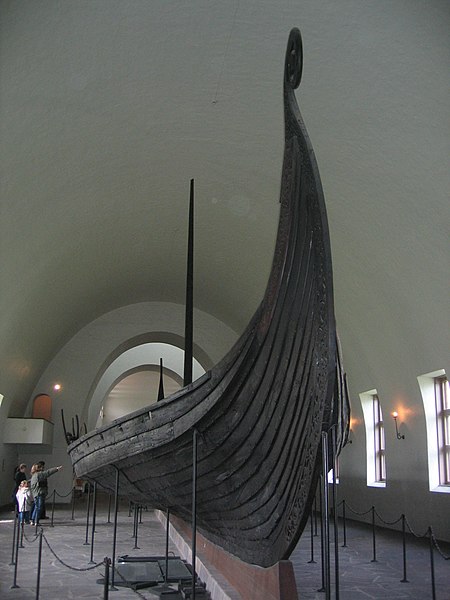The "vikings" were raiders, traders and settlers from Scandinavia who were active in Europe from the late 8th to the early 11th century. "To go Viking" is a Norse expression meaning something like "to become a pirate," so technically it should refer only to a small part of the population only some of the time. But historians tend to call all the Norse Vikings, and to the whole period when they were active as the Viking Age.
Early Raiders
The Norse people were primarily farmers, not nomads. Viking raids were a way to gain wealth and status in seasons between farming. Most expeditions were sponsored by local chieftains who could afford the warships necessary for the journey. The earliest targets were coastal settlements and monasteries, which the Vikings could raid and flee before resistance could be gathered against them. Typical of such hit and run tactics was the first recorded raid, against Lindesfarne in Northumbria (793).
Viking Warfare
 |
| The Oseberg ship. Wikipedia. |
Viking raiders were usually farmers. They were typically armed with a standard dark age round shield and a cheap weapon such as a spear or an axe. Only the wealthy would own a sword, a helm or a chain-mail shirt.
From Contact to Conquest in Western Europe
The raids intensified and became larger in scale.
Vikings seized coastal river areas.
The “Great Army” attacked Francia and England, raiding the French rivers in the 840s and 850s. When resistance grew fierce it moved to Britain. The resulting conquests of the northern English kingdoms became the “Danelaw.”
Many Vikings settled down to become farmers in these new lands. In Normandy, the Viking Rollo (Hrolf) became a noble of the Frankish king and converted to Christianity (911). In England, the Vikings ruled from York for many years. In Ireland, the Vikings founded or expanded many coastal cities, including Dublin. The Vikings intermarried with the peoples of these regions, creating syncretic cultures.
North Atlantic Settlements
Iceland was mostly uninhabited when discovered by men from Norway (c. 870). It quickly became a haven for people opposed to the king. It was the largest Norse settlement in the North Atlantic. The medieval Icelanders had a reputation as poets. Even today, the Icelanders speak the language of the Vikings, largely unchanged, much as we today can read Chaucer or Shakespeare. It is to Iceland that we owe many of our sources about the Viking Age, recorded much later (c. 1200 onwards) in Christian Iceland:
- The Sagas (Histories and local stories)
- The Eddas (Mythological poems and stories)
- Skaldic Poetry (poems of praise)














